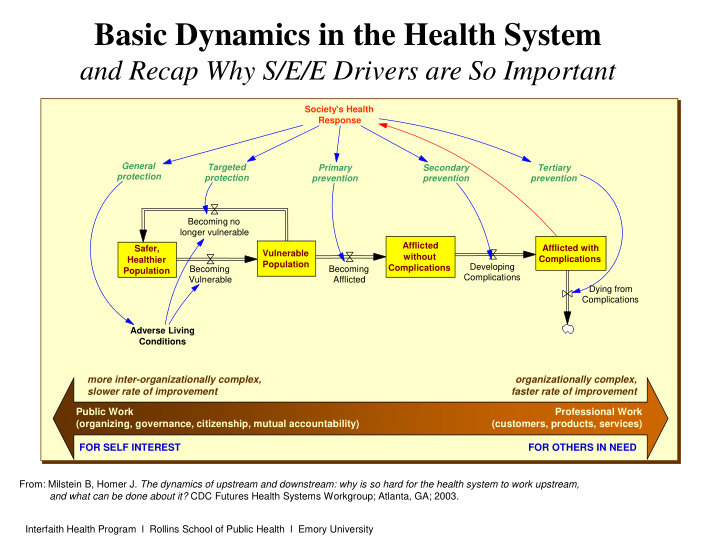



Basic Dynamics in the Health System and Recap Why S/E/E Drivers are So Important Society's Health Response General Targeted Primary Secondary Tertiary protection protection prevention prevention prevention Becoming no longer vulnerable Afflicted Safer, Afflicted with Vulnerable without Healthier Complications Population Developing Complications Becoming Becoming Population Complications Vulnerable Afflicted Dying from Complications Adverse Living Conditions more inter-organizationally complex, organizationally complex, slower rate of improvement faster rate of improvement Public Work Professional Work (organizing, governance, citizenship, mutual accountability) (customers, products, services) FOR SELF INTEREST FOR OTHERS IN NEED From: Milstein B, Homer J. The dynamics of upstream and downstream: why is so hard for the health system to work upstream, and what can be done about it? CDC Futures Health Systems Workgroup; Atlanta, GA; 2003. Interfaith Health Program l Rollins School of Public Health l Emory University
A Rare Opportunity to Complement Downstream Health Care with Upstream Health Action Society's Health Healthy Public Policy Medical and Public Health Policy Response General Targeted Primary Secondary Tertiary protection protection prevention prevention prevention Becoming no longer vulnerable Afflicted Safer, Afflicted with Vulnerable without Complications Healthier Population Developing Complications Becoming Becoming Population Complications Vulnerable Afflicted Dying from Complications Adverse Living Conditions BCBSMF Initiative World of Transforming … By Strengthening … World of Providing … • Deprivation • Leaders • Education • Dependency • Institutions • Screening • Violence • The meaning of work • Disease management • Disconnection • Mutual accountability • Pharmaceuticals • Environmental decay • Plurality • Clinical services • Stress • Democracy • Physical and financial access • Insecurity • Freedom • Etc… • Etc… • Etc… Interfaith Health Program l Rollins School of Public Health l Emory University
New BCBSMF Program Directions Local Minnesota-wide Action Action Broad-based Cross-sector Work Issues Agenda Special Communities Macro/Policy Populations • Growing Up • Minnesota Decides • C H Workers Healthy • TCWF Policy Brief • REACH • Bethel New Life • HIA/Social Reports • STEP • North Karelia •“Northstar Corps” • Literacy
Tips for Staying Healthy : A Lifestyle Approach Don’t smoke. If you do stop. If you can’t cut back. 1. 2. Eat a balanced diet, eat plenty of fruits and vegetables. 3. Keep physically active. 4. If you drink, do so in moderation. 5. Cover up in the sun and protect your children. 6. Practice safe sex. 7. Participate in appropriate health screening. Drive defensively; don’t drink and drive. 8. 9. Manage your stress. 10. Maintain social ties Interfaith Health Program l Rollins School of Public Health l Emory University
Tips for Staying Healthy: A Social Determinants Approach Don’t be poor. If you can, stop. If you can’t, try 1. not to be poor for too long. Don’t have poor parents. 2. Don’t live in a poor neighborhood. 3. Own a car – but use only for weekend outings. 4. Walk to work. Practice not losing your job and don’t become 5. unemployed. Don’t be illiterate. 6. 7. Avoid social isolation. Interfaith Health Program l Rollins School of Public Health l Emory University
Recommend
More recommend